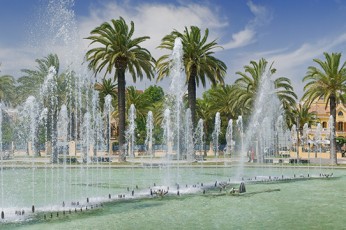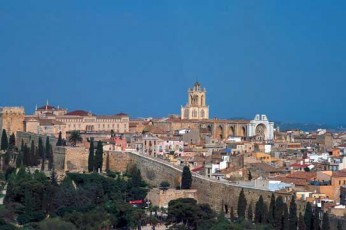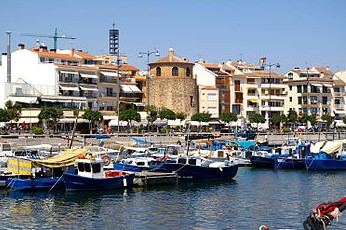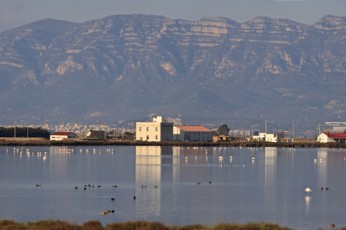
The Costa Dorada, with 92 kilometres of coast along Tarragona province, limits the Garraf Coast on the north and the Azahar Coast on the south. The “Golden Coast” takes its name from the colour of its sand when the sun is shining. This coast is graced with a Mediterranean climate, little rain, average temperatures range from approximately 14º in autumn/winter and 21º and 29º in summer.
Many of its attractions are the Roman archaeological complex which was declared a World Heritage Site by UNESCO, Port Aventura theme park, one of the better attractions if you travel with children, hiking routes along the Montsant Mountains and the innumerable beaches of fine sand.

Salou is the capital of La Costa Dorada. Thanks to its golden sand beaches, its low depth waters and the variety of services it offers, Salou has been awarded ISO 14001 Environmental Certification.
Its longest beach is Platja de Llevant, which can be visited along the promenade Jaime I, full of palm trees, services and leisure facilities such as restaurants, bars,discos, Illuminated Fountain designed by the engineer Carles Buigas and The Bonet House, an example of modernist architecture. The Old Tower of Salou, was built by the Archbishop of Tarragona, Pere de Cardona in 1530 with the aim of protecting and warning the city of pirate attacks. It was the starting point for King Jaime I who set his journey to conquer Mallorca. The Faro of Salou, is one of the most important lighthouses in The Costa Dorada with a light that illuminates the sailors to more than twenty miles. It was built on the cliffs at the top of Cabo de Salou.
For decades now, Salou has been a pioneering and modern destination with an extremely enticing night-life where you will find a great variety of pubs, discos and bars.

Tarragona is the political, commercial and economic capital of the southern of Catalonia. It was founded in 218 B.C. The city has conserved an important Roman architectural and heritage legacy which was declared a World Heritage Site by UNESCO. Some of the more notable sites include the city Walls, the Roman Circus, the Amphitheatre, the Scipio Tower and Bará Arch on the outskirts of the city.
CIt’s a city with an active port and 14-kilometre coastline dotted with multiple beaches and coves surrounded by rocks and pine forests, such as The Miracle beach. Tarragona also offers an interesting gastronomy in El Serrallo quarter, the fisherman’s neighbourhood. And for the night lovers, the sailing club, where there are lots of pubs to have fun.

Cambrilsis a seafaring village where the life revolves around the harbour. It extends its beaches along nine kilometres of coastline where you can do sea sports and enjoy a gastronomy based on local fish and seafood (always prepared with extra virgin olive oil Siruana denomination of origin). The origin of the settleme area of Villa de la Llosa. From the modernist age, it has been preserved a former cooperative wine cellar went of Cambrils dates back to the Roman times which still remains in thhich nowadays is the Agricultural Museum.
National interest of the natural heritage of Cambrils highlight the marshes, located between the beach of l’Esquirol and Cavel and the Fisherman’s, Pinaret and Parc Samà, The last one, Samà Park, is a listed historical garden, Cultural Asset of National Interest that evokes the romantic spirit of the colonial era in Cuba in the fourteenth century.

Reus is one of the towns with more commercial and cultural activity. It is a medieval origin town with almost a thousand years of history. The city had its moment of glory in the late of eighteenth century thanks to the moonshine export which was produced in the town. Reus was the first European market, thus, as the saying goes, “Reus, Paris and London”. This was the order of the price Bulletin.
At the end of the nineteenth century and beginning of the twentieth many important modernist buildings were built. For instance Pere Mata high School, Casa Navàs, Casa Rull and Casa Gasull. Is the city where Antoni Gaudí was born. It still preserves the most symbolic places of his childhood, such as Gaudí Centre. Today, Reus is characterized by the great commercial dynamism of his historic centre, which is diversified and of great quality and also by the intense cultural and festive life all year.

Vila-seca, in the past, it means in Arabic “villa of the road” or “at the edge of the way”. The Iberos and the Celts had already lived in this place when the Greeks arrived. Later, in the third century B.C., the Romans settled at the Racò Beach. When the Arabs arrived in Camp de Tarragona in the VIII century, Vila-seca was used as a borderline between Christians and Arabs. It was in the eighteenth century when a demographic and commercial explosion took place in this area thanks to the commercialization of moonshine in Reus and the local harbour in Salou.
Today, Vila-seca is a well-established resort. An excellent location in a natural, well-cared for environment with first-class facilities. One of the main attractions are Port Aventura theme park and Aquopolis water park. La Pineda beach has over three kilometres long. It’s a very important tourism resource which has been awarded by the European Blue Flag, granted by the European Foundation for Environmental Education. La Pineda also offers a variety of leisure and entertainment at night.

It is curious to see how the two regions of Catalonia which produce wine have developed historically next to two monasteries. In the north, in l’Empordà region, Sant Pere de Roda Monastery and in Tarragona Lands Scala-Dei Monastery, in El Prioratregion.
The name Priorat has been linked to wine since ancient times. This mountainous region is located near of the Mediterranean Sea. It is a world totally different from the near coast. This region is a land of steep rock-faces and ravines of wonderful views, hundred-year-old vineyards, hidden monasteries and villages characterized by the environment. Today, the great labour of wine growers and experts has been the result of a large number of wineries in the Priorat region
Nowadays various activities, related to leisure and active tourism, are surrounded by nature. Interesting activities such as wine and olive oil routes, hiking, cycling tourism, traditions, etc.

The Ebro Delta is located in the south of Tarragona. It’s the largest wetland in Catalonia, one of the most important in Europe. It was declared Natural Park in 1983 and a Biosphere Reserve of Terres de l’Ebre, with 320 square kilometres, which offers us a natural area of great biological wealth.
Is one of those places where nature and the hand of man, the natural and cultural legacies of centuries of history are deeply mixed to create a special atmosphere.
In the Ebro lands, Tourism can be divided into three categories, natural areas, the natural heritage and gastronomy. There are lots of ways of enjoying those places: by bicycle, on foot, riding a horse, fishing in the calm waters of the Ebro river, kayaking, birdwatching, etc.

At the beginning of the twentieth century the Catalan-Aragonese sovereigns entrust the Cistercians the foundation of centres with a lot of agricultural lands which gave life to economy and demography of the new territories. It’s under this reign when the Cister Order is established in Catalonia.
The Cistercian Route is a triangle connecting the monasteries of Poblet, Santes Creus and Vallbona de Les Monges. They are an essential visit for those who want to enjoy great spots, gastronomy,hiking and for those who are passionate about history and medieval architecture.

The Royal Monastery of Pobletis located next to the mountains of Prades. It was declared World Heritage Site by UNESCO in 1991. It’s an impressive architectural complex and one of the most important and well preserved in Europe. The Monastery of Santes Creus is located in Camp de Tarragona, next to the valley of Gaià river.
The Monastery of Vallbona de Les Monges, a monastery of Cistercian nuns, is situated in the southern of Urgell region, in a valley next to El Tellat mountains. The Cistercian Route, is a link connecting the three monasteries, founded in 1989. It has been an important achievement for the rural and cultural tourism of Catalonia.

